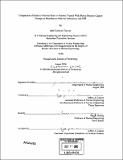| dc.contributor.advisor | Jeffrey A. Coderre. | en_US |
| dc.contributor.author | Turcotte, Julie Catherine | en_US |
| dc.contributor.other | Massachusetts Institute of Technology. Dept. of Nuclear Engineering. | en_US |
| dc.date.accessioned | 2006-07-31T15:18:33Z | |
| dc.date.available | 2006-07-31T15:18:33Z | |
| dc.date.copyright | 2004 | en_US |
| dc.date.issued | 2004 | en_US |
| dc.identifier.uri | http://hdl.handle.net/1721.1/33631 | |
| dc.description | Thesis (S.M.)--Massachusetts Institute of Technology, Dept. of Nuclear Engineering, 2004. | en_US |
| dc.description | Includes bibliographical references. | en_US |
| dc.description.abstract | A number of boron neutron capture therapy (BNCT) clinical trials are currently underway around the world. Due to the small number of patients at each of the individual centers, it is desirable to pool the clinical data from each into one patient database. Before this can be done, a number of differences between the clinical centers must be evaluated. The patients treated at the BNCT centers at Brookhaven National Laboratory and that at Harvard-MIT will be evaluated as a start to the ultimate pooling of all the BNCT centers. One difference involves the difference between the normal tissue composition definition between the institutions. In particular, the difference in weight percent of ¹⁴N must be evaluated. This particular component of tissue is of importance due to the dose to tissue resulting from the ¹⁴N(n,p)¹⁴ C reaction. The difference between the 1.8% ¹⁴N composition used at BNL and the 2.2% used at MIT has a negligible effect on the total dose. Most importantly, differences in dosimetry techniques between the different centers must be computed. Once these differences are quantified, the patients can be pooled, and a better estimate of the normal brain tolerance to BNCT can be determined. | en_US |
| dc.description.abstract | (cont.) The thermal neutron doses calculated from thermal flux measurements are 8% lower when measured by MIT, the gamma dose measurements are 26% lower, and the in-air fast neutron measurements are 27% lower in the same beam. The endpoint used for the tolerance of normal brain to BNCT is somnolence syndrome. A 50% somnolence response can be seen at 5.5 Gy-Eq. | en_US |
| dc.description.statementofresponsibility | by Julie Catherine Turcotte. | en_US |
| dc.format.extent | 88 leaves | en_US |
| dc.format.extent | 4512849 bytes | |
| dc.format.extent | 4516471 bytes | |
| dc.format.mimetype | application/pdf | |
| dc.format.mimetype | application/pdf | |
| dc.language.iso | eng | en_US |
| dc.publisher | Massachusetts Institute of Technology | en_US |
| dc.rights | M.I.T. theses are protected by copyright. They may be viewed from this source for any purpose, but reproduction or distribution in any format is prohibited without written permission. See provided URL for inquiries about permission. | en_US |
| dc.rights.uri | http://dspace.mit.edu/handle/1721.1/7582 | |
| dc.subject | Nuclear Engineering. | en_US |
| dc.title | Comparison of doses to normal brain in patients treated with boron neuron capture therapy at Brookhaven National Laboratory and MIT | en_US |
| dc.type | Thesis | en_US |
| dc.description.degree | S.M. | en_US |
| dc.contributor.department | Massachusetts Institute of Technology. Department of Nuclear Engineering | en_US |
| dc.contributor.department | Massachusetts Institute of Technology. Department of Nuclear Science and Engineering | |
| dc.identifier.oclc | 64392861 | en_US |

